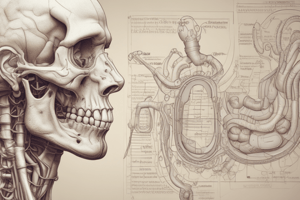Podcast
Questions and Answers
What is the primary function of the hepatic portal vein?
What is the primary function of the hepatic portal vein?
- To supply oxygenated blood to the liver
- To drain bile from the small intestine to the liver
- To transport bile from the liver to the gallbladder
- To carry nutrient-rich blood from the digestive organs (correct)
Which of the following structures is NOT located on the posterior surface of the liver?
Which of the following structures is NOT located on the posterior surface of the liver?
- Quadrate lobe
- Right lobe (correct)
- Caudate lobe
- Falciform ligament
What is the name of the duct that carries bile from the liver to the gallbladder?
What is the name of the duct that carries bile from the liver to the gallbladder?
- Common hepatic duct
- Right hepatic duct
- Cystic duct (correct)
- Left hepatic duct
What is the name of the functional units of the liver that consist of a central vein surrounded by hepatocytes and sinusoids?
What is the name of the functional units of the liver that consist of a central vein surrounded by hepatocytes and sinusoids?
How many segments does the liver have, each with its own blood supply and bile drainage?
How many segments does the liver have, each with its own blood supply and bile drainage?
What is the name of the artery that supplies oxygenated blood to the liver?
What is the name of the artery that supplies oxygenated blood to the liver?
Flashcards are hidden until you start studying
Study Notes
Location and Structure
• The liver is located in the right upper quadrant of the abdominal cavity, beneath the diaphragm. • It is a vital organ, protected by the rib cage. • The liver is divided into four lobes: right, left, caudate, and quadrate.
Lobes and Segments
• The right and left lobes are separated by the falciform ligament. • The caudate lobe is located on the posterior surface of the liver, and the quadrate lobe is located on the inferior surface. • The liver is further divided into eight segments, each with its own blood supply and bile drainage.
Blood Supply
• The liver receives blood from two sources: 1. Oxygenated blood: from the hepatic artery, which arises from the celiac artery. 2. Nutrient-rich blood: from the hepatic portal vein, which carries blood from the digestive organs.
Bile Production and Drainage
• The liver produces bile, which is stored in the gallbladder. • Bile is transported through the right and left hepatic ducts, which merge to form the common hepatic duct. • The common hepatic duct joins the cystic duct from the gallbladder to form the common bile duct. • The common bile duct empties into the duodenum, the first part of the small intestine.
Functional Units
• The liver is composed of functional units called hepatic lobules. • Each lobule consists of a central vein surrounded by hepatic cells (hepatocytes) and sinusoids. • Hepatocytes perform various metabolic functions, including detoxification, protein synthesis, and glycogen storage. • Sinusoids are specialized blood vessels that allow for the exchange of substances between the blood and hepatocytes.
Studying That Suits You
Use AI to generate personalized quizzes and flashcards to suit your learning preferences.




